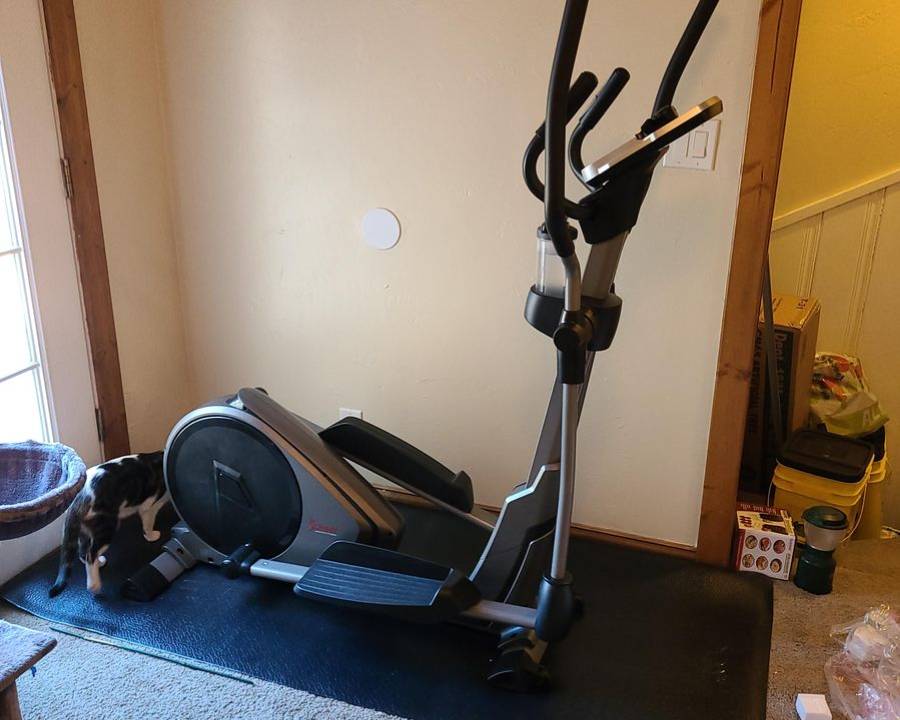
The elliptical trainer has become very popular in recent years, often found in fitness rooms and home gyms. It is especially favored by people starting their fitness journey again. Elliptical trainers, which have either a front or rear flywheel, offer many benefits. These trainers are known for their user-friendly design, allowing for natural and easy-to-replicate movement.
If you want to buy an elliptical machine to do home sessions, you have to ask yourself the question of which model to buy: front or rear drive elliptical trainer? This article discusses the different characteristics of each of them to help you make the right choice.
Front Drive Elliptical

The front-drive elliptical trainer is a relatively new model and is less common than rear-drive models. It operates differently, as the pedals are located at the front. This design encourages users to lean forward and exert more effort while pedaling. The stride is flatter and longer, and the pedals move more slowly and in a less circular motion compared to rear-drive models. As a result, workouts on a front-drive elliptical trainer can be more intense.
The front-drive elliptical offers many advantages. It engages most of the body’s muscles, including the calves, thighs, buttocks, chest, and shoulders. This type of model helps tone the entire body and is excellent for improving cardiovascular fitness. Front-drive elliptical trainers can assist you in losing weight, particularly in the abdominal area. However, it’s less effective for weight loss compared to training on a rear-drive elliptical trainer.
Rear Drive Elliptical

Elliptical with a flywheel and rear brake system is the original model. It dominated the market for years before the front-drive model made its appearance. It is less but still growing in the market. Rear-wheel elliptical trainer has its flywheel and pedals at the rear. Their rotation goes faster than on the front-wheel model. The movements are also more lively when pedaling. You can exert less effort when using it and lose fat effectively without noticing it.
Like the front-drive elliptical, individuals use about 80% of their muscles on rear-drive models. However, the forces are less intense on the rear-drive elliptical, allowing for a gentler workout that minimizes fatigue. This model is recommended for those who are familiar with running or walking.
This type of elliptical is ideal for improving cardiovascular fitness and supporting longer workouts. It is recommended for people who are overweight or looking to return to exercise after an injury. Rear-drive elliptical trainers have fewer parts, which makes them easier to maintain.
Front or Rear Drive Ellipticals: Which One to Choose?
The choice between a front or rear drive elliptical trainer should be made according to your needs: do you want to slim down or build muscle? A front-drive model will allow you to train intensively and lose fat mass. While a rear-drive elliptical trainer will help you build muscle faster. The rear drive model is also effective for someone who needs to recover from an injury.
Buyer’s Guide
Let’s see how to choose between front and rear drive ellipticals…
Seek the advice of a specialist
The elliptical trainer is a comprehensive piece of exercise equipment, but it’s important to use it correctly. We strongly recommend consulting a doctor before starting any new exercise routine, including investing in an elliptical trainer.
Consider your goals
Both types of elliptical trainers offer similar advantages. As mentioned earlier, the front-drive model focuses on strengthening the body, while the rear-drive model is better suited for weight loss. Your choice should depend on your specific fitness goals.
The flywheel
Whatever model you choose, it is essential to take into account the weight of the inertia wheel. Indeed, it is an important component of the machine. The more it weighs, the more regular and comfortable its rotation. Therefore, the training session will be even more efficient.
If you have planned to use it occasionally, opt for a flywheel weight between 6 and 7 kilos. For more frequent use, a flywheel between 10 to 18 kilograms is perfect. To practice sports intensively, choose a flywheel that weighs more than 18 kilograms.
How the brakes work
Elliptical trainers come with three types of braking systems: manual magnetic, electromagnetic, and motorized magnetic. The motorized magnetic system is the most desirable option because it combines the comfort and benefits of the other two systems.
Handles and size
When choosing an elliptical trainer, it’s important to consider your height. It’s best to select a model that is over 130 cm and features movable handles, allowing you to engage your arms during your workout.
Bike console and pulse sensor
If you want to improve your cardiovascular fitness, choose an elliptical trainer with a heart rate sensor. This feature allows you to track your performance and adjust your training program as needed.
The console acts as an onboard computer that provides training data, displaying information such as calories burned, distance covered, speed, and more. Most consoles also include pre-programmed workouts for different fitness goals.
Conclusion
The elliptical trainer simulates the movement of cross-country skiing and offers an excellent way to exercise, burn calories, and improve cardiovascular endurance. So, should you opt for a front or rear-drive elliptical? If your goal is to build muscle, the front-drive model is ideal. If you’re focused on losing belly fat and shedding weight, the rear-drive option is better suited. Both types, however, provide a complete workout, making them great choices for anyone looking to get back into shape and boost cardiovascular health.
Frequently Asked Questions (FAQs):
Which one provides a smoother stride – front or rear-drive ellipticals?
Both front and rear-drive ellipticals can offer a smooth stride. However, some users find that front-drive models mimic a more natural walking or running motion, while others appreciate the compact design of rear-drive machines. It ultimately depends on personal preference.
Are front-drive ellipticals more space-efficient than rear-drive ones?
Yes. Generally, front-drive ellipticals are more compact and space-efficient. The design allows for a smaller footprint, making them suitable for those with limited workout space at home.
Do rear-drive ellipticals provide a more stable workout platform?
Rear-drive ellipticals often have a longer frame for a stable and grounded feeling during workouts. This can be beneficial for users who prioritize stability, especially during intense or vigorous exercise sessions.
Are there any differences in terms of maintenance between the two types?
Maintenance requirements are usually similar for both front and rear-drive ellipticals. Regular cleaning, lubrication, and checking for loose bolts are essential for keeping either machine in good working condition.
See Also…